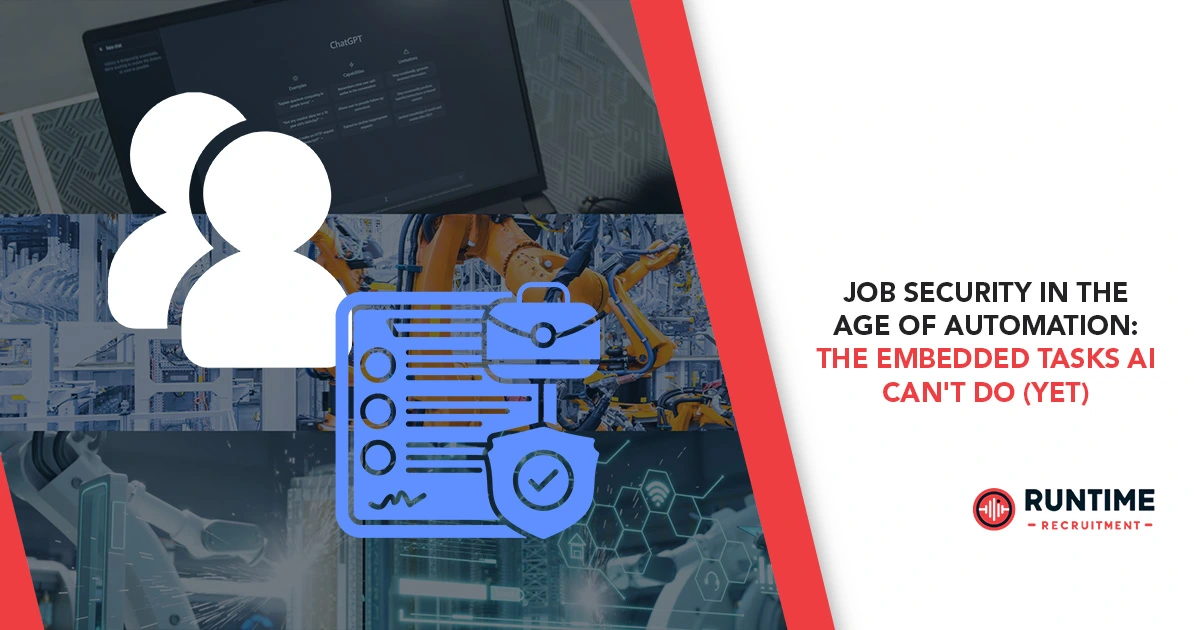The hum of the server room, the intricate dance of etched silicon, the quiet satisfaction of a perfectly optimized interrupt handler – for embedded engineers, these are the hallmarks of a profession that has long been both challenging and incredibly rewarding. For decades, embedded systems have been the invisible backbone of our technological world, from the washing machine in your laundry room to the Mars rover exploring distant planets. But as the relentless march of Artificial Intelligence and automation continues its trajectory, a question increasingly whispers through the digital corridors: “What about my job?”
It’s a valid concern, one that echoes across many industries. AI’s ability to automate repetitive tasks, analyze vast datasets, and even generate code has led to both awe and apprehension. Are embedded engineers destined to become relics of a bygone era, their meticulously crafted C code replaced by a few lines of Python churned out by a neural network?
While the landscape is undoubtedly shifting, and change is the only constant, the answer for embedded engineers is a resounding and nuanced “not yet.” In fact, rather than a threat, AI presents an unprecedented opportunity for those willing to adapt, innovate, and lean into the unique strengths that define the embedded domain. This article will delve into the specific areas where the human touch, intuition, and deep understanding of physical constraints remain irreplaceable, highlighting the “embedded tasks AI can’t do (yet).”
The Unseen World: Beyond the Abstraction Layer
One of the fundamental distinctions between traditional software engineering and embedded systems is the profound interaction with the physical world. Embedded systems are not just about algorithms; they are about electrons flowing, motors spinning, sensors detecting, and power budgets being meticulously managed. This direct connection to hardware introduces a layer of complexity and nuance that current AI models struggle to grasp.
1. Hardware-Software Co-Design and Optimization:
At its core, embedded engineering is a symbiotic relationship between hardware and software. You don’t just write code; you design around the limitations and capabilities of a specific microcontroller, FPGA, or custom ASIC. This involves:
- Pin Multiplexing and Peripheral Configuration: Deciding which GPIO pin does what, configuring timers, ADC channels, UARTs, SPI, and I2C buses. This isn’t just a coding exercise; it’s a deep understanding of the silicon’s datasheet, its errata, and its real-world behavior. An AI might suggest a configuration based on common patterns, but it lacks the intuition to spot subtle conflicts, power implications, or timing criticalities that can only be understood by someone intimately familiar with the hardware.
- Power Optimization at the Granular Level: Every milliampere matters. Embedded engineers go to extreme lengths to minimize power consumption, from selecting low-power components to implementing intricate sleep modes, clock gating, and dynamic voltage scaling. This isn’t just about turning things off; it’s about intelligent management based on application state, external events, and predicted usage patterns. An AI can optimize code for efficiency, but it struggles with the holistic system-level power considerations that span hardware selection, PCB layout, and software control.
- Thermal Management and Mechanical Constraints: An embedded system doesn’t exist in a vacuum. It lives within an enclosure, potentially exposed to varying temperatures, vibrations, and electromagnetic interference. Engineers must consider heat dissipation, component placement, connector durability, and shielding. These are physical challenges with digital solutions, demanding a multi-disciplinary approach that AI currently lacks.
- Custom Hardware Bring-up and Debugging: The first time a new PCB comes back from fabrication is a moment of both excitement and trepidation. Bringing up custom hardware, identifying manufacturing defects, power issues, or signal integrity problems, requires a combination of electrical engineering knowledge, oscilloscope proficiency, and often, sheer grit. Debugging a non-booting board is a highly iterative, diagnostic process that leverages human pattern recognition and hypothesis testing in a way that goes far beyond what current AI can manage.
2. Real-time Operating Systems (RTOS) and Deterministic Behavior:
Many embedded systems are critically time-sensitive. A medical device monitoring vital signs, an automotive control system, or an industrial robot arm cannot tolerate unpredictable delays. This is where RTOS knowledge becomes paramount.
- Task Scheduling and Priority Inversion: Designing robust real-time applications requires a deep understanding of task priorities, inter-task communication mechanisms (queues, semaphores, mutexes), and the avoidance of issues like priority inversion and deadlocks. While AI can analyze code for potential concurrency bugs, it struggles with the nuanced design decisions that prevent these issues in the first place, especially when external, asynchronous events are involved.
- Interrupt Service Routines (ISRs) and Latency: Handling interrupts efficiently and with minimal latency is a cornerstone of embedded programming. ISRs must be short, fast, and avoid blocking operations. Designing the interaction between ISRs and main application tasks, ensuring data integrity across these boundaries, and debugging complex timing issues remains a highly specialized human skill.
- Worst-Case Execution Time (WCET) Analysis: For safety-critical systems, it’s not enough for a task to usually meet its deadline; it must always meet its deadline, even under worst-case scenarios. Calculating and guaranteeing WCET requires detailed knowledge of the processor architecture, compiler optimizations, and the specific application’s control flow – a level of deterministic analysis that current AI models are ill-equipped to perform reliably across diverse hardware platforms.
The Art of the Imperfect: Dealing with the Real World’s Messiness
Unlike the pristine, well-defined environments of many software applications, embedded systems operate in the often chaotic and unpredictable real world. This introduces challenges that defy purely algorithmic solutions.
3. Sensor Fusion and Noise Filtering in the Physical Domain:
Sensors are the eyes and ears of an embedded system, but they rarely provide perfect data. Noise, drift, calibration errors, and environmental interference are constant companions.
- Selecting the Right Sensor for the Job: This isn’t just about reading a datasheet. It’s about understanding the application’s true requirements: accuracy, precision, resolution, response time, robustness, and cost. An AI can compare specs, but it lacks the experiential knowledge to know which sensor really performs well in a dusty factory floor versus a clean lab environment.
- Designing Custom Filters and Calibration Routines: While standard digital filters exist, embedded engineers often need to design custom Kalman filters, complementary filters, or adaptive algorithms tailored to specific sensor characteristics and application needs. This requires a deep understanding of signal processing theory combined with practical insights into the physical phenomena being measured.
- Dealing with Edge Cases and Anomalies: What happens when a sensor fails? When it reports an out-of-range value? Or when environmental conditions change dramatically? Embedded engineers must design robust error handling and fault tolerance mechanisms that anticipate these “real-world” problems. This isn’t just about catching exceptions; it’s about intelligent degradation, recovery strategies, and maintaining system integrity in the face of partial failures.
4. Low-Level Protocol Development and Integration:
Communication is key, but in the embedded world, “communication” can mean anything from a custom bit-banging protocol over GPIO to complex industrial Ethernet stacks.
- Developing Custom Communication Protocols: When off-the-shelf solutions don’t fit, embedded engineers often design their own compact, efficient protocols optimized for specific hardware constraints (e.g., limited RAM, low bandwidth). This involves defining frame structures, error checking, and state machines – a creative design task that goes beyond simply implementing an existing standard.
- Interfacing with Legacy Systems: The world is full of existing machinery, sensors, and actuators that use arcane or proprietary communication methods. Integrating new embedded systems with these legacy components often requires reverse engineering, custom driver development, and an ability to bridge vastly different technological paradigms.
- Network Stack Optimization for Resource-Constrained Devices: Running TCP/IP, MQTT, or other network protocols on a microcontroller with kilobytes of RAM and limited processing power is a specialized skill. It involves careful selection of lightweight libraries, memory management, and power-aware communication strategies. An AI can generate network code, but it often struggles with the ruthless resource constraints that dictate embedded network design.
The Human Element: Where Intuition and Experience Reign Supreme
Beyond the technical specifics, there are inherent human qualities that remain indispensable in embedded engineering.
5. System Architecture and Holistic Design Thinking:
An embedded system is rarely a standalone component; it’s part of a larger ecosystem. Designing such a system requires a holistic view that transcends individual modules.
- Defining System Requirements from Ambiguous Customer Needs: Customers often know what they want the system to do, but not how it should do it, or what the underlying technical requirements are. Translating vague desires into concrete, measurable technical specifications (e.g., “fast response time” becomes “10ms latency for critical events”) requires human interpretation, questioning, and an understanding of both technical feasibility and business impact.
- Making Trade-offs and Prioritization: Every design involves trade-offs: cost vs. performance, power vs. features, development time vs. robustness. Deciding which compromises to make, based on a deep understanding of the project’s goals, market, and constraints, is a complex decision-making process that relies on experience and strategic thinking. An AI can present data on trade-offs, but the ultimate judgment of what constitutes the “best” balance remains human.
- Future-Proofing and Scalability: Designing for the long term, anticipating future features, maintainability, and scalability, requires foresight and architectural vision. How will the system evolve? Can components be easily swapped out? Is the design flexible enough to adapt to new standards or requirements? These are questions that demand a high level of abstraction and strategic planning.
6. Innovation, Problem Solving, and Debugging Unseen Issues:
Perhaps the most critical, and least automatable, aspects of embedded engineering are creative problem-solving and debugging.
- Root Cause Analysis of Intermittent Bugs: The bane of every embedded engineer’s existence: the bug that only appears once a week, under specific environmental conditions, or after 10,000 hours of operation. Diagnosing these elusive issues often involves a detective-like approach, hypothesis testing, setting up complex test fixtures, and leveraging years of accumulated experience. An AI can analyze logs, but it lacks the intuition to connect disparate pieces of evidence to pinpoint the truly novel or subtle fault.
- Creative Solutions to Unique Problems: Every project brings new challenges. Sometimes, the standard solution won’t work, and a novel approach is required. This could involve an unconventional use of a peripheral, a clever algorithm to squeeze performance from limited resources, or an innovative way to interact with the physical environment. This is where human ingenuity shines.
- Mentorship and Knowledge Transfer: The deep, often tacit knowledge held by experienced embedded engineers is invaluable. Mentoring junior engineers, sharing best practices, and transmitting the accumulated wisdom of the field is a fundamentally human process that builds cohesive and effective teams.
The AI Assistant: A Co-Pilot, Not a Replacement
This isn’t to say AI has no place in embedded engineering. Far from it. AI tools are rapidly becoming invaluable co-pilots, augmenting human capabilities:
- Automated Code Generation for Boilerplate: AI can generate initial driver code, configure peripherals based on high-level descriptions, and speed up repetitive coding tasks.
- Static Analysis and Bug Detection: Advanced AI-powered static analysis tools can identify potential bugs, security vulnerabilities, and adherence to coding standards far more efficiently than manual review.
- Test Case Generation: AI can assist in generating comprehensive test cases, identifying edge conditions that might be overlooked by humans.
- Design Space Exploration: AI can help explore vast design spaces for optimal component selection or system architectures based on predefined constraints.
- Documentation and Code Explanation: AI can assist in generating documentation from code or explaining complex code sections, improving maintainability.
The key is that AI excels at processing vast amounts of data, identifying patterns, and automating well-defined tasks. It struggles with ambiguity, intuition, complex real-world physics, ethical considerations, and true innovation. These are precisely the areas where embedded engineers, with their deep domain knowledge and problem-solving skills, continue to be indispensable.
Embracing the Future: A Call to Action
Job security in the age of automation for embedded engineers doesn’t come from resisting change, but from embracing it. It means:
- Doubling Down on Fundamentals: A strong grasp of electrical engineering, digital design, real-time principles, and low-level programming will always be the bedrock.
- Becoming a Hybrid Engineer: Learn to leverage AI tools effectively. Understand their strengths and weaknesses. Treat them as powerful assistants that free you to focus on higher-level, more complex problems.
- Specializing in “Hard Problems”: Focus on areas that require deep system understanding, creative problem-solving, and interaction with the physical world – those tasks AI can’t do (yet).
- Continuous Learning: The embedded landscape is constantly evolving. Stay abreast of new microcontrollers, communication standards, development tools, and, of course, advancements in AI.
The embedded systems industry is growing, not shrinking. As the Internet of Things (IoT) expands, as autonomous vehicles become a reality, as medical devices become more sophisticated, and as industrial automation reaches new heights, the demand for skilled embedded engineers will only intensify. These are precisely the fields where robust, reliable, and secure interaction with the physical world is paramount – a domain where the human touch remains irreplaceable.
Are you ready to navigate this evolving landscape and secure your future in embedded engineering? Connect with RunTime Recruitment today. We specialize in matching talented embedded engineers with cutting-edge opportunities where your unique skills are valued and thrive.









